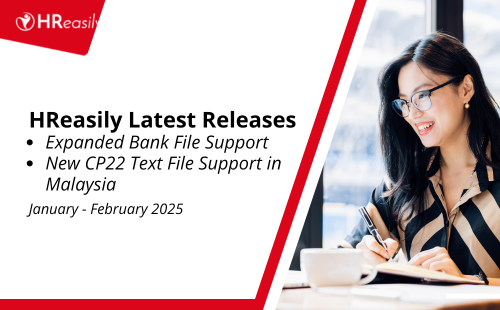
The efficient management of employee leave requests stands as a vital yet frequently challenging endeavour. When not meticulously handled, this process can swiftly evolve into an HR-related ordeal marked by bottlenecks, dissatisfied employees, and a tense workplace atmosphere. Thankfully, cutting-edge HR software solutions like HReasily stand ready to streamline this process, guaranteeing that HR professionals can effortlessly navigate the intricacies of leave management.
The Dilemma of Leave Requests
Leave requests form an indispensable aspect of an organisation’s daily functioning. Employees often require time off for a range of reasons, from vacations to family emergencies and health concerns. Nonetheless, managing these requests can swiftly become a burdensome task, particularly for HR departments within larger enterprises.
Common Pain Points:
1. Paperwork Pileup: The Challenge of Traditional Leave Request Procedures
In traditional leave request procedures, the reliance on extensive paperwork presents a considerable challenge for HR departments. This reliance on physical documents can create a host of issues, contributing to the accumulation of paperwork and the subsequent backlog of leave requests. Here’s an in-depth look at this challenge:
- Document Vulnerability:
Physical documents are susceptible to damage, loss, or misplacement. They can be inadvertently shuffled or misplaced within a filing system, causing delays in processing leave requests. A simple misfiled document can lead to unnecessary confusion and complications.
- Manual Tracking:
With paper-based systems, tracking the status of leave requests and their associated documentation can be a manual and time-consuming process. HR personnel may need to sift through stacks of paperwork to identify the status of pending requests.
- Communication Hurdles:
Paper-based systems can also introduce communication challenges. There may be delays in notifying employees about the approval or denial of their leave requests due to the need for physical transmission of documents.
- Limited Accessibility:
Paperwork is often confined to physical locations, such as HR offices or filing cabinets. This limited accessibility can hinder HR professionals’ ability to work remotely or access leave request information when needed.
- Data Security Concerns:
Storing sensitive employee leave information in physical documents can raise data security concerns. Unauthorised access to or mishandling of these documents may compromise employee privacy.
- Environmental Impact:
Traditional paperwork systems are not environmentally friendly, as they consume a significant amount of resources, such as paper and ink. This approach contributes to an organisation’s carbon footprint.
- Inefficiency and Delays:
The manual handling of paperwork can lead to inefficiencies and unnecessary delays in the leave request process. As the volume of requests grows, HR departments may find it increasingly challenging to keep up with the paperwork.
2. Manual Calculations: The Burden of Accurate Leave Tracking
One of the central challenges faced in managing employee leave requests using manual methods is the need for accurate calculations. This issue extends to the tracking of leave balances, accruals, and the approval process, and it presents several notable difficulties:
- Time-Consuming Tasks:
Manual calculations require HR professionals to invest a significant amount of time and effort in tracking and managing leave balances. This can be particularly onerous in larger organisations with a substantial workforce, as it involves constant monitoring and number crunching.
- Prone to Human Error:
The human element in manual calculations introduces a significant risk of error. HR personnel are susceptible to miscalculations, misinterpretations, and oversight. This can lead to inaccuracies in leave balances, potentially resulting in overallocation or underallocation of leave days.
- Complex Accruals:
In organisations with varying leave policies and accrual rates based on seniority or other factors, manual calculations become even more complex. Ensuring the accuracy of these calculations is a meticulous and error-prone process.
- Inconsistencies in Approvals:
When leave requests are handled manually, inconsistencies may arise in the approval process. HR professionals may face difficulties in ensuring that leave is granted fairly and in accordance with company policies, as manual calculations can lead to discrepancies in determining available leave days.
- Impact on Employee Trust:
Inaccurate leave balances can undermine employee trust in the HR department and the organisation as a whole. Employees may become frustrated if they believe their accrued leave has been mismanaged or if approvals are inconsistent.
- Operational Delays:
The manual nature of these calculations can result in operational delays. HR professionals must dedicate time to perform these tasks, which can slow down the overall leave request process, leading to potential bottlenecks.
- Resource Intensive:
Manual calculations consume valuable HR resources that could be better utilised for strategic HR activities. Rather than focusing on strategic talent management, HR staff may find themselves consumed by administrative tasks.
3. Approval Bottlenecks: The Challenge of Simultaneous Leave Requests
Handling a surge of leave requests from multiple employees simultaneously can pose a significant challenge for HR departments. This scenario often leads to approval bottlenecks, where HR professionals may find it difficult to prioritise and process requests promptly. Here’s a closer look at the complexities involved:
- Prioritisation Dilemma:
When several employees request leave at the same time, HR professionals face a crucial decision regarding the order in which to process these requests. Choosing the wrong priority may lead to dissatisfaction among employees and operational disruptions.
- Limited Resources:
HR departments typically have limited resources, both in terms of staff and time. A sudden influx of leave requests can overwhelm HR personnel, especially in smaller departments or during peak vacation seasons.
- Competing Needs:
Simultaneous leave requests can create situations where employees with equally valid reasons for time off are in direct competition for the same dates. Deciding which requests to approve and which to deny can be a complex and delicate task.
- Communication Challenges:
Coordinating and communicating with employees regarding the status of their leave requests can be challenging when numerous requests are under consideration. Delayed or unclear communication can lead to frustration among employees.
- Operational Disruption:
An inability to process leave requests in a timely manner can disrupt regular operations and work schedules. It can leave departments short-staffed, impacting productivity and service quality.
- Employee Morale Impact:
Approval bottlenecks can lead to dissatisfaction among employees. If their leave requests are consistently delayed or denied, it can negatively affect employee morale, potentially leading to reduced engagement and performance.
- Regulatory Compliance:
Failing to process leave requests promptly can also have implications for regulatory compliance. Labour laws may require timely responses to leave requests, and violating these requirements can result in legal consequences for the organisation.
4. Employee Frustration: The Impact of Delayed Leave Approvals
When employees experience delays in the approval of their leave requests, it can result in feelings of frustration and dissatisfaction. These emotional responses can have significant consequences for both the individual employees and the organisation as a whole:
- Morale Deterioration:
Employees who feel their leave requests are not being addressed promptly may experience a decline in their morale. They might perceive their needs as unimportant or unacknowledged, which can lead to disengagement and reduced enthusiasm for their work.
- Productivity Decline:
Frustrated employees are less likely to be productive. Their focus and commitment to their tasks may decrease as they grapple with unresolved leave requests. This can translate into lower work efficiency and output.
- Interpersonal Conflicts:
Delays in leave approvals can also trigger interpersonal conflicts within the workplace. If employees have to cover for their absent colleagues due to delayed approvals, it may lead to strained relationships and tension among coworkers.
- Quality of Work:
When employees are unhappy or frustrated, the quality of their work may suffer. Errors or lapses in judgement could occur more frequently, impacting the overall quality of products or services.
- Retention Risk:
Employees who continually face difficulties in getting their leave requests approved may begin to explore other employment opportunities. Employee retention can be jeopardised as a result.
HReasily Leave Feature: A Solution to the HR Nightmare
HReasily, an innovative HR management software, offers a robust Leave feature that addresses these pain points and streamlines the entire leave request process.
- Online Leave Requests: HReasily allows employees to submit leave requests online, eliminating the need for physical paperwork and reducing the risk of misplacement.
- Automated Leave Balances: The software automatically calculates leave balances, making it easy for HR professionals to track and manage employee leave accruals accurately.
- Advanced Approval Workflow: HReasily offers a flexible approval workflow, allowing HR departments to set rules and hierarchies for leave request approvals. This eliminates bottlenecks and ensures efficient processing.
- Self-Service Apps: Employees can view their leave balances, submit requests, and check the status of their applications through self-service portals, reducing the need for constant HR intervention.
- Real-Time Insights: The software provides real-time insights and reports, enabling HR professionals to make data-driven decisions and plan for leave coverage proactively.
Benefits of HReasily Leave Feature: A Transformative Solution
HReasily leave feature brings a host of benefits to the world of HR and leave management, effectively addressing various pain points and streamlining the entire process. Here’s an elaboration on these key advantages:
Efficiency:
HR professionals can process leave requests with remarkable speed and efficiency. Automated workflows and streamlined processes reduce the likelihood of leave request backlogs, ensuring that time-sensitive requests are addressed promptly. This enhanced efficiency enables HR teams to allocate more time to strategic HR tasks, ultimately benefiting the organisation’s overall operations.
Accuracy:
The feature’s automated calculations and tracking mechanisms significantly reduce the risk of human errors in leave balance management. Accurate record-keeping ensures that employees receive their entitled leave days and prevents discrepancies or overallocation of leave. The result is a more dependable and trustworthy system that fosters transparency and trust among employees.
Employee Satisfaction:
Self-service apps offered by HReasily empower employees to take control of their leave requests. They can easily check their leave balances, submit requests, and monitor the status of their applications. This user-friendly approach leads to happier employees who feel more engaged and involved in their own leave management. Timely approvals further boost employee satisfaction, creating a positive work environment where employees feel their needs are acknowledged and respected.
Compliance:
HReasily ensures that organisations stay compliant with both labour laws and their own internal policies when managing employee leave. By automating leave processes and adhering to established rules and regulations, HReasily minimises the risk of compliance violations. This not only safeguards the organisation from potential legal repercussions but also reinforces its commitment to ethical and responsible HR practices.
Time and Cost Savings:
Streamlining the leave request process results in significant time and cost savings for HR departments. The automation of various tasks reduces the need for extensive manual labour and allows HR professionals to allocate their resources more efficiently. Consequently, HR staff can focus on strategic HR functions and employee development, contributing to the organisation’s growth and prosperity while saving valuable resources.
HReasily leave feature serves as a revolutionary solution, granting HR professionals the tools to handle leave requests with precision, efficiency, and adherence to compliance. Through its capacity to enhance accuracy, elevate employee satisfaction, and diminish time and cost constraints, this feature notably improves the leave management process, yielding benefits for HR teams and the entire organisation. In doing so, it contributes to the cultivation of a harmonious and streamlined work environment where leave management becomes a straightforward and trouble-free endeavour.
Manage your employee’s leave more efficiently today. Try HReasily 30-day trial today !
Prefer a personalised solution? Worry not, our representative can assist you. Email us at [email protected] and share with us your concerns!










